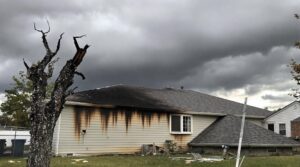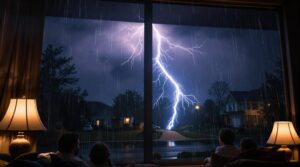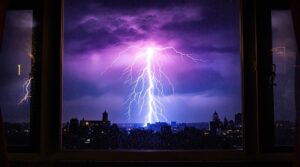When lightning strikes a house, the sound is often described as a loud, intense bang or crack, similar to a thunderclap, but with a more immediate and violent quality. The noise is caused by the rapid expansion of air along the path of the lightning bolt, creating a shockwave that can shatter windows and damage structural elements. As the sound fades, other signs of damage may become apparent, revealing the full extent of the strike's impact.
Key Takeaways
- A lightning strike on a house produces an extremely loud bang, often compared to a thunderclap, which can cause hearing damage.
- Vibrations from the strike resonate through the structure, potentially causing structural damage and producing rumbling or shaking sounds.
- Electrical system damage can cause buzzing, crackling, or hissing sounds due to the surge of energy from the strike.
- The intensity and type of sounds vary depending on the location, force, and material involvement of the strike.
- Recognizing these sounds can aid in swift reactions and informed decisions during a lightning strike emergency.
Immediate Aftermath of a Lightning Strike
Following a lightning strike, the immediate aftermath is often characterized by intense auditory and visual effects. A loud bang or crack is commonly reported, as experienced by a homeowner in Luzerne County during a storm. The sound is typically accompanied by a flash of light, which can be overwhelming. The strike can also cause a surge of energy, resulting in damage such as charred light switches and shattered vinyl siding.
In addition to the sensory effects, a lightning hit can cause immediate panic, leading individuals to drop to the floor. Firefighters may be called to the scene due to smoke detection, highlighting the potential for secondary hazards even when no fire is present. Electrical disruptions can also occur, as demonstrated by a homeowner's truck exhibiting alarm indicators and failing to start after the strike. These effects underscore the severity of a lightning strike's immediate aftermath.
Deciphering the Sounds of a Lightning Hit
The intense auditory effects of a lightning strike play a significant role in its immediate aftermath. When lightning strikes a house, the resulting sound can be deafening and chaotic. The impact can produce a shockwave that resonates through the structure, causing vibrations that may be felt indoors.
| Sound Characteristics | Description | Potential Effects |
|---|---|---|
| Loud Bang | Thunderclap-like sound | Hearing damage |
| Vibrations | Resonates through structure | Structural damage |
| Buzzing/Crackling | Electrical system damage | Fire risk |
The sounds produced by lightning strikes can vary in intensity and material involvement. In some cases, the aftermath may include audible disturbances from damaged electrical systems, such as buzzing or crackling sounds. Understanding the different sounds associated with lightning strikes is vital for prompt and effective response to minimize damage and guarantee safety. Recognizing these sounds can help individuals react swiftly and make informed decisions in the chaotic moments following a lightning strike.
A Homeowner's Terrifying Experience
As the intense flash of light illuminated the surrounding area, a loud bang immediately ensued, signaling the moment when lightning struck the house, an event that would leave the homeowner shaken and prompting swift action. The homeowner reported a terrifying moment of panic, followed by the discovery of shattered vinyl siding on the ground and charred light switches, indicative of the powerful energy surge caused by the lightning. Dropping to the floor in fear, the homeowner quickly called 911 for assistance, feeling alone and anxious as they awaited help. The physical impact of the lightning strike was evident, with burn marks on the family truck and damage to the driveway. This harrowing experience prompted the homeowner to contemplate future precautions to mitigate the risk of future lightning strikes. The lightning strike left an indelible mark, serving as a stark reminder of the power and unpredictability of lightning.
Potential Damage to Property and Belongings
Property damage is a significant concern when a lightning strike occurs. A direct hit from a lightning bolt can cause extensive destruction to a house and surrounding property. As seen in a reported incident in Luzerne County, the impact shattered vinyl siding, throwing debris to the ground. Electrical components, such as light switches and smoke detectors, may be charred and rendered inoperable due to the surge of electricity. Vehicles parked nearby can also suffer damage, displaying burn marks, as observed on a family truck following a lightning strike. Chunks of concrete may be removed from driveways, and ceiling lights can detach, highlighting the force of the strike. Alarms and sensors may trigger, indicating problems such as a vehicle's failure to start, demonstrating the immediate effects of a lightning strike on property and belongings. The full extent of damage depends on the specific circumstances of the strike.
Preparing for the Unpredictable Nature of Lightning Strikes
Because lightning strikes can occur without warning, homeowners must prioritize preparation to mitigate potential damage. One essential step is to install lightning rods or taller structures, such as flagpoles, to direct electrical energy safely away from homes. This helps to minimize the risk of damage and fire. Homeowners should also make sure their property is equipped with surge protectors and smoke detectors, which can help to minimize damage and alert them of potential hazards after a lightning strike.
In the event of a storm, residents are advised to GO INSIDE and seek shelter in a safe location. Communities can benefit from increased awareness campaigns about lightning safety measures, emphasizing the importance of seeking shelter indoors during storms. By taking proactive measures, homeowners can reduce the risk of damage and guarantee their safety during a lightning strike. Preparation is key to mitigating the unpredictable nature of lightning strikes.








